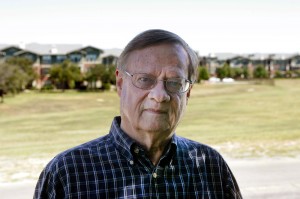As supporters were working to get Forest Park on a diet, opponents were organizing as well.
Some critics in the Berkeley Place and Mistletoe Heights neighborhoods say that their objections haven’t been taken seriously. Those outside the area also believe they should get a say in the matter, because many people who live outside of the neighborhoods use Forest Park as a commuter route into downtown.
John Davis, who lives in Bluebonnet Hills, thinks the plan was created with little regard for the street’s functionality.
“Some of the people in Berkeley and Mistletoe Heights — and I don’t even believe a majority — like to say it’s their street because it runs through their neighborhood,” he said. “Well, University Drive runs through my neighborhood, yet it [also] goes other places. If this were a street only used by neighbors, that would be relevant.

“Everybody I know, except the people who have publicly supported it, thinks it’s just a stupid idea,” he said.
Evans, who attended the meeting at the Hilton, said in his letter to residents that he spoke with the project’s engineers who told him that Forest Park wasn’t a particularly dangerous road.
“At the end of our meeting, I asked the engineers if Forest Park was a dangerous road as it presently exists,” he wrote. “They said based on traffic flow data, they ‘could not say that it is a dangerous road.’ ”
Mistletoe Heights resident Jim Malloy was also at the meeting, which he called “basically a pep rally for the road diet.”
An avid cyclist, he said the meeting was filled with “a large contingency of the bicycling community.”
The city council adopted a bike plan in February 2010 that will add more than 800 miles to Fort Worth’s bike-transportation network, with the vast majority of those miles being on-street lanes and shared routes. The goals of the ambitious plan include tripling the number of bicycle commuters and decreasing bike-related crashes by 10 percent.
Malloy is opposed to the Forest Park project because he believes it will make his commute more difficult.
“The reason I would be against it is because I live west, and there’s no other way for us to get out of the neighborhood other than Forest Park Boulevard,” he said. “If I lived east, if the traffic was blocked off, I could get on 8th Avenue.”
Evans believes that drivers will still jockey for position on the street, using the turn lane as a passing lane. “Everyone will be forced to drive at the speed chosen by the slowest driver,” he said. The re-striping “will cause frustrated drivers to dart into the turn lane at a higher speed.”
Davis said that a few irresponsible drivers should not ruin the street for everyone.
“It’s like the library,” he said. “People come in and deface the books. Well we can’t just make it so you can’t use the library. We’re going to make the street much less useable.
He fears that Forest Park will turn into “another Magnolia,” which he said has become unusable as a transportation artery.
“I believe the people on Magnolia — and that includes Steer Fort Worth and Fort Worth South — they really did believe that if they did the things they did on Magnolia, it would simply make it a street [that] people would want to avoid,” Davis said.
Mike Brennan, a planner for Fort Worth South Inc., said that he fields lots of complaints from residents and business owners, but that’s he’s never heard any about traffic circulation on Magnolia.
“We do hear praise about how Magnolia, in its current condition, seems to work in many more ways than when it was a four-lane road. It works as a way for motorists to get from 8th Avenue to Hemphill, it works for pedestrians, people eating [at sidewalk tables], and cyclists who are able to travel along Magnolia safely in their designated space.”
Malloy believes the city should try other measures before re-striping, including taking down trees on the Forest Park easement that make it difficult to see oncoming traffic.
“I believe if they put an unmanned police car out there and from time to time have a police office out there, that would be a deterrent,” he said.
Jordan believes that the Chisholm Trail Parkway will alleviate some of the traffic flow on the street and make it safer. “My concern is that it would be a lot easier if those commuters had another alternative other than University or 8th Avenue,” he said.
Burns disagreed.
“Having less traffic on Forest Park doesn’t make it any safer,” he said. “People will potentially speed up more.”
Those on board with the road diet tout its success in other cities. On Orlando’s Edgewater Drive, a street with roughly the same amount of traffic as Forest Park and running through both commercial and residential blocks, re-striping resulted in a reduction of accidents by 34 percent — even though there was an increase in traffic.
Malloy said his hometown of Baytown did something similar in the 1970s, and the change affected traffic, including slowing down emergency vehicles.
“They reduced the main street in town from four lanes to two to eliminate teenagers from cruising at night,” Malloy said. “It was a disaster in that police and [emergency medical technicians] were unable to respond to accidents, injuries, or fights, due to the logjam caused by reduction of lanes along with the unabated traffic.”
Fort Worth presents its own set of problems. Costa said the city was designed with automobiles in mind, not pedestrians or public transportation.
“It’s fair to say that in the past couple of generations, as the automobile has become a prevalent part of our culture, we’ve tended to design cities for automobiles,” he said. But now, he said, residents’ attitudes are changing and so are the ideas of city planners about street design.
“There was a time in Fort Worth when we didn’t require new subdivisions to require sidewalks. Now we do,” he said. “There was a time when we built arterial streets without sidewalks. So we’ve created unsafe streets, or streets that are unusable by pedestrians.
“We ought to be making it safe and convenient for pedestrians to walk around. It’s good for the community, businesses, and the environment,” Costa said.
In 2007 the Texas Department of Transportation rebuilt a 1.5-mile section of West Rosedale Street with $12 million of federal money. Last year the city spent roughly $5.5 million to improve parts of the same stretch, with onstreet parking, bike lanes, wider sidewalks, and lighting. The city is also rebuilding the medians to include irrigation and greenery.
********











